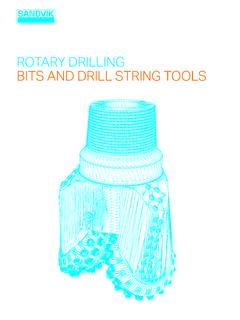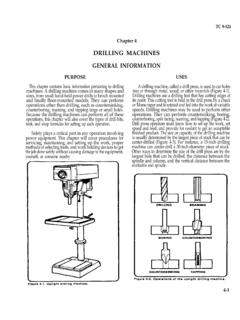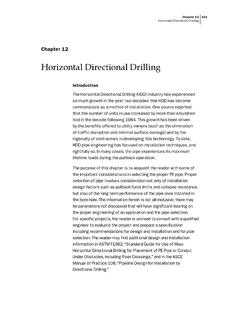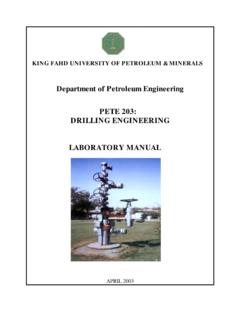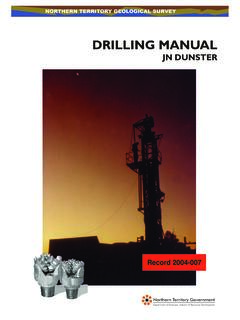Transcription of Vehicle-Mounted Drilling Rigs for Rock and Concrete
1 CONTROL OF SILICA DUST IN CONSTRUCTION Vehicle-Mounted Drilling Rigs for Rock and ConcreteUsing Drilling rigs mounted on trucks, crawlers, or other vehicles to drill into rock or Concrete can generate respirable crystalline silica dust. When inhaled, the small particles of silica can irreversibly damage the lungs. This fact sheet describes dust controls that can be used to minimize the amount of airborne dust when using Vehicle-Mounted Drilling rigs for rock and Concrete as listed in Table 1 of the Respirable Crystalline Silica Standard for Construction, 29 CFR 1926 .1 Control Method: Dust collection systems with water sprays at the discharge point OR Operator isolation in an enclosed cab with water on drill bitDust Collection Systems/Wet MethodsDust-collecting equipment for Vehicle-Mounted drills includes a movable duct attached to a close capture hood or shroud around the drill bit, and a flexible rubber skirt that encloses the drill hole opening and captures cuttings that come through the air is pulled from inside the shroud through a flexible duct to primary and secondary filter media.
2 The primary filter or dust separator often includes a self-cleaning back-pulse feature that dumps the collected particles to the release of particles to the air is minimized by a low-flow water spray at the discharge point. Equipment without these controls can be retrofitted by the manufacturer or a mechanical courtesy of NIOSHW ater mistDiagram of dust control systems for rock drills, including deck shrouds for the drill bit and the discharge or dump shroud. The dust collection systems are most effective when good design and maintenance practices are implemented by skilled and properly trained operators. Deck Shroud Design. Use a one-piece shroudthat fully encloses the area around the drill or replace torn or missing pieces andmake sure that gaps are sealed.
3 Adequate Airflow. The dust collector should bedesigned to draw more air than the bailing airused to flush out cuttings from the drill hole. Thedust collector air volume should be three timesthe bailing air volume. Water Injection at Dust Collector Exhaust. Addingsmall amounts of water into the air dischargeduct can significantly reduce the release of silicadust in the dump area. When adding water tothe discharge duct, slowly increase the rate untilthere is no visible dust. Check the duct interiordaily and clear dust deposits that may form in it. Fan Exhaust Placement. Extend the dustcollection system exhaust port so that the dustyair releases away from workers. Clogged ductsand filters restrict dust collector airflow.
4 Removedust that collects on filters and in flexible ducts. Fan Maintenance. Dust can damage the fanmotor, blades, and drill bits. Replace wornparts. Check for excessive vibration in fanbelts, coupling, and belt alignment, and wornor broken belts, blades, mounting bolts, andbushings. Repair and maintain as needed. Filters. Replace clogged or damaged air filtersand avoid exposure to dust when cleaning orreplacing Isolation/Wet MethodsThe alternative to using a dust-collection system is operator isolation in an enclosed cab or booth, along with applying water to the drill bit during cutting to reduce operators using Vehicle-Mounted rigs with enclosed cabs can reduce their silica exposure by staying inside the cab during Drilling .
5 The cab must: Be well-sealed and well-ventilated using positive pressure. Have door jambs, window grooves, powerline entries, and other joints that work properly and are tightly sealed. Have heating and air conditioning so that operators can keep windows and doors closed. Use an intake air filter with a minimum MERV-16 rating (at least 95% in the m range). Be kept free from settled dust by regular cleaning and maintenance to prevent dust from become airborne inside the courtesy of NIOSHV ehicle-mounted Drilling rigs with dust collection system around drill bit and low-flow water spray to wet the dust discharged from the dust collector. The enclosed operator s cab is on the right.
6 The dust collection system is on the left. In wet Drilling systems that use forced air (bailing air) to flush cuttings from the hole, water is added to the bailing air at the drill head. Small particles join to form larger particles, thus reducing escaping respirable dust. The proper use of wet methods requires a trained and skilled operator. Too much water can create mud slurry at the bottom of the hole that can trap the bit, coupling, and steel extensions. Too little water will not effectively control escaping ProtectionWhen properly used, dust collection systems and operator isolation can effectively control exposure to silica , this Table 1 entry does not require the use of respiratory protection when operating Drilling rigs equipped with a dust collection system or from within an enclosed InformationFor more information, visit and see the OSHA Fact Sheet on the Crystalline Silica Rule for Construction, and the Small Entity Compliance Guide for the Respirable Crystalline Silica Standard for can provide compliance assistance through a variety of programs.
7 Including technical assistance about effective safety and health programs, workplace consultations, and training and education. OSHA s On-Site Consultation Program offers free, confidential occupational safety and health services to small and medium-sized businesses in all states and several territories across the country, with priority given to high-hazard worksites. On-Site consultation services are separate from enforcement and do not result in penalties or citations. To locate the OSHA On-Site Consultation Program nearest you, visit www. osha. to Contact OSHAU nder the Occupational Safety and Health Act of 1970, employers are responsible for providing safe and healthful workplaces for their employees.
8 OSHA s role is to ensure these conditions for America s working men and women by setting and enforcing standards, and providing training, education and assistance. For more information, visit www. or call OSHA at 1-800-321-OSHA (6742), TTY FS-3931 12/2017 This is one in a series of informational fact sheets highlighting OSHA programs, policies or standards. It does not impose any new compliance requirements. For a comprehensive list of compliance requirements of OSHA standards or regulations, refer to Title 29 of the Code of Federal Regulations. This information will be made available to sensory-impaired individuals upon request. The voice phone is (202) 693-1999; teletypewriter (TTY) number: (877) 889-5627.










